| University of Copenhagen |
| Københavns Universitet |
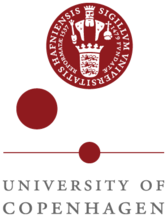 |
| 拉丁语: Universitas Hafniensis |
| 校训 |
Coelestem adspicit lucem (拉丁语) |
| 英语校训 |
It looks at the celestial light |
| 建立于 |
1479 |
| 类型 |
Public university |
| 捐赠 |
DKK 6,467,000,000 ($1.25 Billion) (2008) |
| Rector |
Ralf Hemmingsen |
| 工作人员 |
~ 7,000
~ 5,500 full-time equivalents |
| 学生 |
37,986 (1 October 2007) |
| 位置 |
Copenhagen,  Denmark Denmark |
| 校园 |
central (city),
north,
south (formerly Amager) and
west (Frederiksberg) |
| 归属 |
IARU, EUA |
| 网址 |
www.ku.dk/english/ |
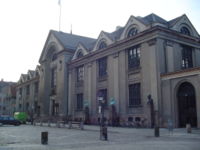
Main campus on Frue Plads.
The University of Copenhagen (Danish: Københavns Universitet) is the oldest and largest university and research institution in Denmark. Founded in 1479, it has more than 37,000 students, the majority of whom are female (59%), and more than 7,000 employees. The university has several campuses located in and around Copenhagen, with the oldest located in central Copenhagen. Most courses are taught in Danish; however, many courses are also offered in English and a few in German. The university has 2800 foreign students of which about half are from Nordic countries.
The university is a member of the International Alliance of Research Universities (IARU), along with University of Cambridge, University of Oxford, Yale University and UC Berkeley, amongst others. The Academic Ranking of World Universities, compiled by Shanghai Jiao Tong University, sees Copenhagen as the leading university in Scandinavia and amongst the 50 best universities in the world. The university is generally understood to be one of Europe's leading research institutions. The university has had 9 alumni become Nobel laureates and 1 Turing award recipient.
Organization and administration
The university is governed by a board consisting of 11 members: 6 members recruited outside the university form the majority of the board, 2 members are appointed by the scientific staff, 1 member is appointed by the administrative staff, and 2 members are appointed by the university students. The Rector is appointed by the university board. The rector in turn appoints deans and deans appoint heads of departments. There is no faculty senate and faculty is not involved in the appointment of rector, deans, or department heads. Hence the university has no faculty governance.
Faculties
The University of Copenhagen currently has eight faculties, although the composition and number of faculties has changed over time.
- Faculty of Health Sciences
- Faculty of Humanities
- Faculty of Law
- Faculty of Life Sciences
- Faculty of Pharmaceutical Sciences
- Faculty of Science
- Faculty of Social Sciences
- Faculty of Theology
校园
The university campus is located over four sites in Copenhagen:
- North Campus
- Faculty of Health Sciences
- Faculty of Pharmaceutical Sciences
- Faculty of Science
- Biotech Research & Innovation Centre
- City Campus
- Faculty of Law
- Faculty of Social Sciences
- Faculty of Theology
- Central Administration
- South Campus (former Amager Campus)
- Frederiksberg Campus
历史
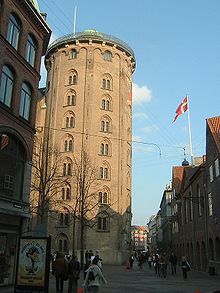
The Rundetårn (round tower) was used in the 17th century as an observatory by Ole Rømer.
The University of Copenhagen was founded in 1479 and is the oldest university in Denmark. Between the closing of the Studium Generale in Lund in 1536 and the establishment of the University of Aarhus in the late 1920s, it was the only university in Denmark. The university became a centre of Roman Catholic theological learning, but also had faculties for the study of law, medicine, and philosophy.
The university was re-established in 1537 after the Lutheran Reformation and transformed into an evangelical-Lutheran seminary. Between 1675 and 1788, the university introduced the concept of degree examinations. An examination for theology was added in 1675, followed by law in 1736. By 1788, all faculties required an examination before they would issue a degree.
In 1801, under the command of Admiral Horatio Nelson, the British fleet bombarded Copenhagen during the Battle of Copenhagen, destroying most of the university's buildings. By 1836, however, the new main building of the university was inaugurated amid extensive building that continued until the end of the century. The university library, the Zoological Museum, the Geological Museum, the Botanic Garden with greenhouses, and the Technical College were also established during this period.
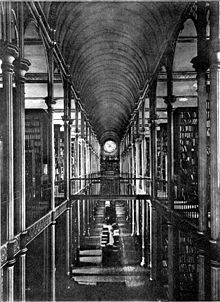
Interior of the old university library at Fiolstræde around 1920.
Between 1842 and 1850, the faculties at the university were restructured. Starting in 1842, the University Faculty of Medicine and the Academy of Surgeons merged to form the Faculty of Medical Science, while in 1848 the Faculty of Law was reorganised and became the Faculty of Jurisprudence and Political Science. In 1850, the Faculty of Mathematics and Science was separated from the Faculty of Philosophy.
The first female student was enrolled at the university in 1877. The university underwent explosive growth between 1960 and 1980. The number of students rose from around 6,000 in 1960 to about 26,000 in 1980, with a correspondingly large growth in the number of employees. Buildings built during this time period include the new Zoological Museum, the Hans Christian Ørsted and August Krogh Institutes, the campus centre on Amager Island, and the Panum Institute.
The new university statute instituted in 1970 involved democratisation of the management of the university. It was modified in 1973 and subsequently applied to all higher education institutions in Denmark. The democratisation was later reversed with the 2003 university reforms. Further change in the structure of the university from 1990 to 1993 made a Bachelor's degree programme mandatory in virtually all subjects.
Also in 1993, the law departments broke off from the Faculty of Social Sciences to form a separate Faculty of Law. In 1994, the University of Copenhagen designated environmental studies, north-south relations, and biotechnology as areas of special priority according to its new long-term plan. Starting in 1996 and continuing to the present, the university planned new buildings, including for the University of Copenhagen Faculty of Humanities at Amager (Ørestaden), along with a Biotechnology Centre. By 1999, the student population had grown to exceed 35,000, resulting in the university appointing additional professors and other personnel.
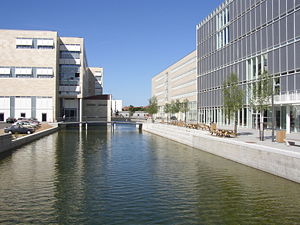
The Faculty of Humanities.
In 2003, the revised Danish university law removed faculty, staff and students from the university decision process, creating a top-down control structure that has been described as absolute monarchy, since leaders are granted extensive powers while being appointed exclusively by higher levels in the organization.
In 2005, the Center for Health and Society (Center for Sundhed og Samfund - CSS) opened in central Copenhagen, housing the Faculty of Social Sciences and Institute of Public Health, which until then had been located in various places throughout the city. In May 2006, the university announced further plans to leave many of its old buildings in the inner city of Copenhagen, an area that has been home to the university for more than 500 years. The purpose of this has been to gather the university's many departments and faculties on three larger campuses in order to create a bigger, more concentrated and modern student environment with better teaching facilities, as well as to save money on rent and maintenance of the old buildings. The concentration of facilities on larger campuses also allows for more inter-disciplinary cooperation; for example, the Departments of Political Science and Sociology are now located in the same facilities at CSS and can pool resources more easily.
In January 2007, the University of Copenhagen merged with the Royal Veterinary and Agricultural University and the Danish University of Pharmaceutical Science. The two universities are now faculties under the University of Copenhagen, and are now known as the Faculty of Life Sciences and the Faculty of Pharmaceutical Sciences.
Student housing
Although many privately owned dormitories (kollegier in Danish) exist in Copenhagen, there are also five which are partially administered by the university. Only students who have passed at least two years of studies are considered for admission. These are normally referred to as the old dormitories, and they consist of Regensen, Elers' Kollegium, Borchs Kollegium, Hassagers Kollegium, and Valkendorfs Kollegium.
Contrary to the tradition of most American dormitories, Danish dormitories in general, and the old dormitories in particular, only offer single rooms for rent, meaning no student has to share their room with others. Many Danish students live in dormitories throughout their studies.
The seal
The oldest seal only exists on a letter from 1531 and it depicts Saint Peter with a key and a book. In a circle around him is the text
- Sigillum universitatis studii haffnensis.
When the university was re-established by Christian III in 1537 after the Protestant Reformation, it received a new seal. The seal shows the king with crown, sceptre, and globus cruciger sitting above a coat of arms that contains the Danish coat of arms in the upper right part and the Norwegian coat in the left. The text is
- Sigillum Universitatis Hafniensis A Christiano III Rege Restauravit
|
- Seal of the University of Copenhagen, reestablished by King Christian III.
|
The 1537 seal is very similar to the current seal, shown at the top of this page. The text is different and there is only the national coat of arms of Denmark on the seal. The coat of arms has a crown and contains three lions and nine hearts. The text is
- Sigillum Universitatis Hafniensis
- Fundatæ 1479
- Reformatæ 1537
|
- Seal of the University of Copenhagen.
- Founded 1479
- Reformed 1537
|
In addition to the university seal, each of the university's eight faculties have a seal of their own.
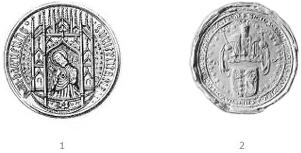
The seal of 1531 (1) and the seal of 1537 (2)
International reputation
Both the THES/QS ranking of 2008 and Global University Ranking of 2009 place University of Copenhagen as number 48 in the world.
The Academic Ranking of World Universities published by Shanghai Jiao Tong University 2007 ranks the University of Copenhagen as the best university in Denmark and Scandinavia, the 8th best university in Europe, and is #46 in Top 500 World Universities rankings.
The university cooperates with universities around the world. In January 2006, the University of Copenhagen entered into a partnership of ten universities, along with the Australian National University, ETH Zürich, National University of Singapore, Peking University, University of California Berkeley, University of Cambridge, University of Oxford, University of Tokyo and Yale University. The partnership is referred to as the International Alliance of Research Universities (IARU)./nn20050712b2.htm
On the 2009 THE–QS World University Rankings list, the University of Copenhagen was ranked inside the top 100 for the sixth consecutive year. An overview of the last years.
| Year |
Rank (change) |
| 2004 |
63 |
| 2005 |
66 (▼ 3) |
| 2006 |
54 (▲ 12) |
| 2007 |
93 (▼ 39) |
| 2008 |
48 (▲ 45) |
| 2009 |
51 (▼ 3) |
Notable alumni
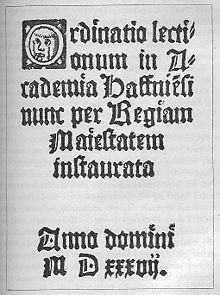
The oldest surviving lecture plan from the university is from 1537.
- Sir Ove Arup (1896–1988), Anglo-Danish structural engineer.
- Halldór Ásgrímsson (1947 -), Prime Minister of Iceland (2004–2006).
- Caspar Bartholin (1585–1629), professor in medicine and theology. Author of textbooks on anatomy and the discoverer of the workings of the olfactory nerve.
- Rasmus Bartholin (1625–1698), professor in geometry and medicine. Discovered birefringence, but was unable to give a scientific explanation.
- Thomas Bartholin (1616–1680), discoverer of the lymphatic system.
- Aage Bohr (1922–2009), professor in nuclear physics and director of the Niels Bohr Institute at the university. Nobel laureate in Physics (1975).
- Niels Bohr (1885–1962), contributed to development of the Atomic model and Quantum Mechanics. Director at the university's Institute of Theoretical Physics. Nobel laureate in Physics (1922).
- Georg Brandes (1842–1927), Danish writer and critic.
- Tycho Brahe (1546–1601), Danish astronomer, first scientific documentation of supernovas, mentor of Johannes Kepler.
- Morten Thrane Brunnich (1737–1827), Danish zoologist.
- Henrik Dam, Nobel laureate in Medicine (1943).
- Magnús Eiríksson (1806–1881), Icelandic theologian.
- Johannes Andreas Grib Fibiger (1867–1928), Nobel laureate in Medicine (1926).
- Thomas Fincke (1561–1656), Danish mathematician and physicist.
- Niels Ryberg Finsen (1860–1904), Nobel laureate in Medicine (1903).
- Nicolai Grundtvig (1783–1872), Danish writer, poet, philosopher and priest.
- Julie Vinter Hansen (1890–1960), Danish astronomer.
- Christopher Hansteen (1784–1873), Norwegian astronomer and physicist.
- Jørgen Haugan(1941-), Doctorate in Philosophy (1977) - Norwegian author and lecturer,
- Johan Ludvig Heiberg (1791–1860), Danish poet and critic.
- Piet Hein (1905–1996), Danish mathematician, inventor and poet.
- Ludvig Holberg (1684–1754), Danish-Norwegian writer and playwright.
- Harald Høffding (1843–1931), Danish philosopher.
- Peter Høeg (1957 - ), Danish fiction writer, won international acclaim with Smilla's Sense of Snow.
- Peder Horrebow (1679–1764), Danish astronomer and member of Académie des Sciences.
- Niels Kaj Jerne (1911–1994), Nobel laureate in Medicine (1984).
- Otto Jespersen (1860–1943), Danish linguist, co-founder of the International Phonetic Association.
- Wilhelm Johannsen (1857–1927), Danish botanist, first coined the word gene in its modern usage.
- Søren Kierkegaard (1813–1855), Danish philosopher, the father of existentialism.
- Thomas Hansen Kingo (1634–1703), Danish bishop and poet.
- Jens Martin Knudsen (1930–2005), Danish astrophysicist.
- Jens Otto Krag (1914–1978), Prime Minister of Denmark (1962–1968) & (1971–1972).
- August Krogh, Nobel laureate in Medicine (1920).
- Frederik Vinding Kruse (1880–1963), Danish jurist.
- Bjørn Lomborg (1965 -), author of The Skeptical Enviromentalist.
- Johan Nicolai Madvig (1804–1886), a Danish philologist and Minister of Culture.
- Kirstine Meyer (1861–1941), Danish physicist.
- Ben Roy Mottelson (1926 -), Nobel laureate in Physics (1975).
- Per Stig Møller (1942 -) Denmark's Minister of Foreign Affairs (2001 -).
- Peter Naur (1928 -), computer scientist, Turing Award in 2005.
- Holger Bech Nielsen (1941 -), a physicist. One of three creators of string theory.
- Adam Gottlob Oehlenschläger (1779–1850), poet, author of lyrics of the Danish national anthem Der er et yndigt land.
- Anders Oersted (1816–1872), professor of botany 1851-1862.
- Rasmus Rask (1787–1832), Danish scholar and philologist.
- Lars Løkke Rasmussen (1964 -), Prime Minister of Denmark (2009 -)
- Poul Nyrup Rasmussen (1943 -), Prime Minister of Denmark (1993–2001).
- Jørgen Rischel (1934–2007), Danish linguist who analyzed Greenlandic and Mon-Khmer languages.
- Ole Rømer (1644–1710), Danish astronomer.
- Poul Schlüter, Prime Minister of Denmark (1982–1993).
- Jens Christian Skou (1918 -) Nobel laureate in Chemistry for his discovery of Na+,K+-ATPase.
- Bengt Strömgren (1908–1987), Danish astronomer and astrophysicist.
- Thor Pedersen (1945 -) Finance Minister of Denmark (2001–2007)
- Vilhelm Thomsen (1842–1927), Danish linguist.
- Helle Thorning-Schmidt (1966 -), Leader of Danish Social Democratic Party
- Martin Vahl (1749–1804), Danish-Norwegian botanist and zoologist.
- Eugenius Warming (1841-1924), Danish boatnist and founding figure of ecology.
- Øjvind Winge (1886–1964), Danish biologist.
- Olaus Wormius (1588–1655), Danish phycisist and antiquarian.
- Anders Sandøe Ørsted (1778–1860), Danish jurist and Prime Minister of Denmark (1853–1854).
- Hans Christian Ørsted (1777–1851), discovered electromagnetism.
参考文献
- ^ http://ed.sjtu.edu.cn/ranking.htm
- ^ http://ed.sjtu.edu.cn/rank/2007/ARWU2007_Top100.htm
- ^ http://www.timeshighereducation.co.uk/hybrid.asp?typeCode=243&pubCode=1&navcode=137
- ^ "Vedtægt for Københavns Universitet". http://bestyrelse.ku.dk/vedtaegt/. Retrieved 2009-11-08.
- ^ http://introduction.ku.dk/campus/
- ^ "Absolut monarki på universiteterne". 23. august 2009. http://www.information.dk/201197. Retrieved 2009-11-20.
- ^ http://www.topuniversities.com/university_rankings/results/2008/overall_rankings/top_100_universities/
- ^ http://www.globaluniversitiesranking.org/images/banners/top-100(eng).pdf
- ^ http://ed.sjtu.edu.cn/ranking.htm
- ^ http://ed.sjtu.edu.cn/rank/2007/ARWU2007_Top100.htm
- ^ http://search.japantimes.co.jp/print/news/nn07-2005
External links
 |
Wikimedia Commons has media related to: University of Copenhagen |
- University of Copenhagen 网址 (Danish) (English)
- University of Copenhagen Alumni - International (English)
- Faculty of Health Sciences website (Danish) (English)
- Faculty of Humanities website (Danish) (English)
- Faculty of Law website (Danish) (English)
- Faculty of Life Sciences website (Danish) (English)
- Faculty of Pharmaceutical Sciences website (Danish) (English)
- Faculty of Science website (Danish) (English)
- Faculty of Social Sciences website (Danish) (English)
- Faculty of Theology website (Danish) (English)
- Student body size as of October 1 2007 (Danish)
- university of Copenhagen in Eduroute ranking
Coordinates: 55°40′47″N 12°34′21″E / 55.67972°N 12.5725°E / 55.67972; 12.5725
|
|



